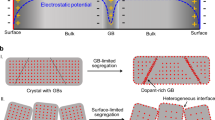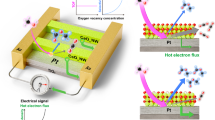Abstract
Ordered heterostructured nanocrystals with large compositional and morphological diversity are important for many applications. However, design of multicomponent nanostructures at the atomic level is difficult due to the elusive nucleation and growth processes in a solution-phase environment. Here we report a modular synthetic protocol that produces ordered multilayered nanostructures with small particle size by layer-by-layer growth. We introduce a selenium capping agent to hinder self-assembly, aggregation and phase segregation of nanostructures, while also sequencing the priority of metal atoms that migrate in the substrate lattice according to different metal–selenium bonding strengths, leading to a layer-by-layer growth for ordered nanostructures. The multilayered multicomponent nanocrystals are demonstrated in an alkaline polymer electrolyte fuel cell by using PtRuZn-SKE (SKE, selenium-mediated Kirkendall effect) as the anodic hydrogen oxidation reaction catalyst, which can deliver a high peak power density of 1.52 W cm−2 in H2–O2 and 1.12 W cm−2 in H2–air (CO2-free) while operating at 600 mA cm−2 for 100 h. This generalizable strategy provides a predictable synthetic pathway to complex nanocrystals.

This is a preview of subscription content, access via your institution
Access options
Subscribe to this journal
Receive 12 digital issues and online access to articles
118,99 € per year
only 9,92 € per issue
Buy this article
- Purchase on SpringerLink
- Instant access to full article PDF
Prices may be subject to local taxes which are calculated during checkout





Similar content being viewed by others
Data availability
Additional characterization data, experimental data, and theoretical calculation data are provided in the Supplementary Information. Source data are provided with this paper.
Code availability
The computational codes used in this work are available within the commercial VASP and the Gaussian 09 packages.
References
Huang, X. et al. High-performance transition metal–doped Pt3Ni octahedra for oxygen reduction reaction. Science 348, 1230–1234 (2015).
Bu, L. et al. Biaxially strained PtPb/Pt core/shell nanoplate boosts oxygen reduction catalysis. Science 354, 1410–1414 (2016).
Cao, L. et al. Atomically dispersed iron hydroxide anchored on Pt for preferential oxidation of CO in H2. Nature 565, 631–635 (2019).
Pang, C. et al. A flexible and highly sensitive strain-gauge sensor using reversible interlocking of nanofibres. Nat. Mater. 11, 795–801 (2012).
Shen, X., Kamath, A. & Guyot-Sionnest, P. Mid-infrared cascade intraband electroluminescence with HgSe–CdSe core–shell colloidal quantum dots. Nat. Photonics 17, 1042–1046 (2023).
Nugroho, F. A. A. et al. Metal–polymer hybrid nanomaterials for plasmonic ultrafast hydrogen detection. Nat. Mater. 18, 489–495 (2019).
Drake, G. A., Keating, L. P. & Shim, M. Design principles of colloidal nanorod heterostructures. Chem. Rev. 123, 3761–3789 (2022).
Yang, T. H., Shi, Y., Janssen, A. & Xia, Y. Surface capping agents and their roles in shape‐controlled synthesis of colloidal metal nanocrystals. Angew. Chem. Int. Ed. 59, 15378–15401 (2020).
Sequeira, C. A. C. & Amaral, L. Role of Kirkendall effect in diffusion processes in solids. Trans. Nonferr. Metal. Soc. 24, 1–11 (2014).
Feng, J. & Yin, Y. Self‐templating approaches to hollow nanostructures. Adv. Mater. 31, 1802349 (2018).
Chee, S. W. et al. Interface-mediated Kirkendall effect and nanoscale void migration in bimetallic nanoparticles during interdiffusion. Nat. Commun. 10, 2831 (2019).
Trogadas, P., Ramani, V., Strasser, P., Fuller, T. F. & Coppens, M. O. Hierarchically structured nanomaterials for electrochemical energy conversion. Angew. Chem. Int. Ed. 55, 122–148 (2016).
Ivanchenko, M., Carroll, A. L., Brothers, A. B. & Jing, H. Facile aqueous synthesis of hollow dual plasmonic hetero-nanostructures with tunable optical responses through nanoscale Kirkendall effects. Nanoscale Adv. 5, 88–95 (2023).
Ivanchenko, M. & Jing, H. Smart design of noble metal–copper chalcogenide dual plasmonic heteronanoarchitectures for emerging applications: progress and prospects. Chem. Mater. 35, 4598–4620 (2023).
Thompson, K. L., Katzbaer, R. R., Terrones, M. & Schaak, R. E. Formation and transformation of Cu2–xSe1–yTey nanoparticles synthesized by tellurium anion exchange of copper selenide. Inorg. Chem. 62, 4550–4557 (2023).
Tsunoyama, H., Ichikuni, N., Sakurai, H. & Tsukuda, T. Effect of electronic structures of Au clusters stabilized by poly(N-vinyl-2-pyrrolidone) on aerobic oxidation catalysis. J. Am. Chem. Soc. 131, 7086–7093 (2009).
Sun, Y. & Xia, Y. Shape-controlled synthesis of gold and silver nanoparticles. Science 298, 2176–2179 (2002).
Fan, H. J., Gösele, U. & Zacharias, M. Formation of nanotubes and hollow nanoparticles based on Kirkendall and diffusion processes: a review. Small 3, 1660–1671 (2007).
Zhan, C. et al. Subnanometer high-entropy alloy nanowires enable remarkable hydrogen oxidation catalysis. Nat. Commun. 12, 6261 (2021).
Hu, X. et al. Platinum–lead–bismuth/platinum–bismuth core/shell nanoplate achieves complete dehydrogenation pathway for direct formic acid oxidation catalysis. J. Am. Chem. Soc. 145, 15109–15117 (2023).
Gallezot, P., Weber, R., Betta, R. A. D. & Boudart, M. Investigation by X-ray absorption spectroscopy of platinum clusters supported on zeolites. Z. Naturforsch. A 34, 40–42 (1979).
Lytle, F. Determination of d-band occupancy in pure metals and supported catalysts by measurement of the LIII X-ray absorption threshold. J. Catal. 43, 376–379 (1976).
Zhou, M. et al. Quantitative analysis of the reduction kinetics responsible for the one-pot synthesis of Pd–Pt bimetallic nanocrystals with different structures. J. Am. Chem. Soc. 138, 12263–12270 (2016).
Luty-Błocho, M., Pacławski, K., Wojnicki, M. & Fitzner, K. The kinetics of redox reaction of gold(III) chloride complex ions with l-ascorbic acid. Inorg. Chim. Acta 395, 189–196 (2013).
Kresse, G. & Furthmüller, J. Efficient iterative schemes for ab initio total-energy calculations using a plane-wave basis set. Phys. Rev. B 54, 11169–11186 (1996).
Huang, J., Valenzano, L., Singh, T. V., Pandey, R. & Sant, G. Influence of (Al, Fe, Mg) impurities on triclinic Ca3SiO5: interpretations from DFT calculations. Cryst. Growth Des. 14, 2158–2171 (2014).
Zhong, Q. et al. Strain-modulated seeded growth of highly branched black Au superparticles for efficient photothermal conversion. J. Am. Chem. Soc. 143, 20513–20523 (2021).
Schwindt, V. C. et al. Selenium adsorption at different coverages on Fe(100) and Fe(111): a DFT study. Appl. Surf. Sci. 315, 252–260 (2014).
Lu, H.-J. et al. First-principles investigation on diffusion mechanism of alloying elements in dilute Zr alloys. Acta Mater. 154, 161–171 (2018).
Van de Walle, C. G. & Neugebauer, J. First-principles calculations for defects and impurities: applications to III-nitrides. J. Appl. Phys. 95, 3851–3879 (2004).
Tu, K.N. & Gusak, A.M. Kinetics in Nanoscale Materials (John Wiley, 2014).
Henkelman, G., Uberuaga, B. P. & Jónsson, H. A climbing image nudged elastic band method for finding saddle points and minimum energy paths. J. Chem. Phys. 113, 9901–9904 (2000).
Tu, K. N. & Gösele, U. Hollow nanostructures based on the Kirkendall effect: design and stability considerations. Appl. Phys. Lett. 86, 093111 (2005).
Shang, S.-L. et al. A comprehensive first-principles study of pure elements: vacancy formation and migration energies and self-diffusion coefficients. Acta Mater. 109, 128–141 (2016).
Troparevsky, M. C., Morris, J. R., Kent, P. R. C., Lupini, A. R. & Stocks, G. M. Criteria for predicting the formation of single-phase high-entropy alloys. Phys. Rev. X 5, 011041 (2015).
Qin, B. et al. A novel IrNi@PdIr/C core–shell electrocatalyst with enhanced activity and durability for the hydrogen oxidation reaction in alkaline anion exchange membrane fuel cells. Nanoscale 10, 4872–4881 (2018).
Miller, H. A. et al. A Pd/C–CeO2 anode catalyst for high‐performance platinum‐free anion exchange membrane fuel cells. Angew. Chem. Int. Ed. 55, 6004–6007 (2016).
Omasta, T. J. et al. Beyond 1.0 W cm−2 performance without platinum: the beginning of a new era in anion exchange membrane fuel cells. J. Electrochem. Soc. 165, J3039–J3044 (2018).
Wang, Y. et al. Pt–Ru catalyzed hydrogen oxidation in alkaline media: oxophilic effect or electronic effect? Energy Environ. Sci. 8, 177–181 (2015).
Wang, T. et al. High-performance hydroxide exchange membrane fuel cells through optimization of relative humidity, backpressure and catalyst selection. J. Electrochem. Soc. 166, F3305–F3310 (2019).
Xue, Y. et al. A highly-active, stable and low-cost platinum-free anode catalyst based on RuNi for hydroxide exchange membrane fuel cells. Nat. Commun. 11, 5651 (2020).
Bellini, M. et al. Palladium–ceria catalysts with enhanced alkaline hydrogen oxidation activity for anion exchange membrane fuel cells. ACS Appl. Energy Mater. 2, 4999–5008 (2019).
Ravel, B. & Newville, M. ATHENA, ARTEMIS, HEPHAESTUS: data analysis for X-ray absorption spectroscopy using IFEFFIT. J. Synchrotron Radiat. 12, 537–541 (2005).
Newville, M. IFEFFIT: interactive XAFS analysis and FEFF fitting. J. Synchrotron Radiat. 8, 322–324 (2001).
Blöchl, P. E. Projector augmented-wave method. Phys. Rev. B 50, 17953–17979 (1994).
Perdew, J. P., Burke, K. & Ernzerhof, M. Generalized gradient approximation made simple. Phys. Rev. Lett. 77, 3865–3868 (1996).
Frisch, M. J. et al. Gaussian 09 (Gaussian Inc., 2009).
Lee, C., Yang, W. & Parr, R. G. Development of the Colle–Salvetti correlation-energy formula into a functional of the electron density. Phys. Rev. B 37, 785–789 (1988).
Hay, P. J. & Wadt, W. R. Ab initio effective core potentials for molecular calculations. Potentials for K to Au including the outermost core orbitals. J. Chem. Phys. 82, 299–310 (1985).
Medasani, B., Haranczyk, M., Canning, A. & Asta, M. Vacancy formation energies in metals: a comparison of MetaGGA with LDA and GGA exchange–correlation functionals. Comp. Mater. Sci. 101, 96–107 (2015).
Vitos, L., Ruban, A. V., Skriver, H. L. & Kollár, J. The surface energy of metals. Surf. Sci. 411, 186–202 (1998).
Neumann, G. & Tuijn, C. Self-diffusion and Impurity Diffusion in Pure Metals Handbook of Experimental Data (Pergamon, 2009).
Acknowledgements
X.H. acknowledges support from the National Key R&D Program of China (2020YFB1505802), the Ministry of Science and Technology (2017YFA0208200), the National Natural Science Foundation of China (22025108, U21A20327, 22121001) and start-up fundings from Xiamen University. J.H. acknowledges support from the National Natural Science Foundation of China (52272256). C.H. acknowledges support from the Postdoctoral Science Foundation of China (2021M702731). J.X. acknowledges the grants from the Research Grants Council of the Hong Kong Special Administrative Region, China (grant number 21301324).
Author information
Authors and Affiliations
Contributions
X.H. supervised the project. C.H. carried out the materials synthesis, electrochemical experiments, electron microscopy experiments, data processing and analysis, and manuscript writing. J.H. performed the DFT calculations. J.X. revised the manuscript. Y.T. Y.T. contacted the spherical aberration transmission electron microscopy testing cooperation. Y.Z. and S.Z. performed the spherical aberration transmission electron microscopy experiments. R.R. and L.Z. conducted the membrane electrode assembly measurements. Q.K. and Z.H. performed the XAS measurements. L.L. analysed the XAS data. All authors discussed and commented on the manuscript.
Corresponding authors
Ethics declarations
Competing interests
The authors declare no competing interests.
Peer review
Peer review information
Nature Synthesis thanks Hao Jing, J. R. Sambrano and the other, anonymous, reviewer(s) for their contribution to the peer review of this work. Primary Handling Editor: Alexandra Groves, in collaboration with the Nature Synthesis team.
Additional information
Publisher’s note Springer Nature remains neutral with regard to jurisdictional claims in published maps and institutional affiliations.
Supplementary information
Supplementary Information
Supplementary Notes 1–6, Figs. 1–69, Tables 1–13 and References.
Source data
Source Data Fig. 1
Statistical source data.
Source Data Fig. 2
Statistical source data.
Source Data Fig. 3
Statistical source data.
Source Data Fig. 4
Statistical source data.
Source Data Fig. 5
Statistical source data.
Rights and permissions
Springer Nature or its licensor (e.g. a society or other partner) holds exclusive rights to this article under a publishing agreement with the author(s) or other rightsholder(s); author self-archiving of the accepted manuscript version of this article is solely governed by the terms of such publishing agreement and applicable law.
About this article
Cite this article
Hu, C., Zhang, Y., Ren, R. et al. A selenium-mediated layer-by-layer synthetic strategy for multilayered multicomponent nanocrystals. Nat. Synth 3, 1299–1309 (2024). https://doi.org/10.1038/s44160-024-00598-2
Received:
Accepted:
Published:
Issue Date:
DOI: https://doi.org/10.1038/s44160-024-00598-2
This article is cited by
-
Strong-weak dual interface engineered electrocatalyst for large current density hydrogen evolution reaction
Communications Materials (2025)
-
Recent advances in high-entropy alloys for electrochemical hydrogen evolution, oxygen reduction, and CO2 reduction reactions
Frontiers in Energy (2025)



